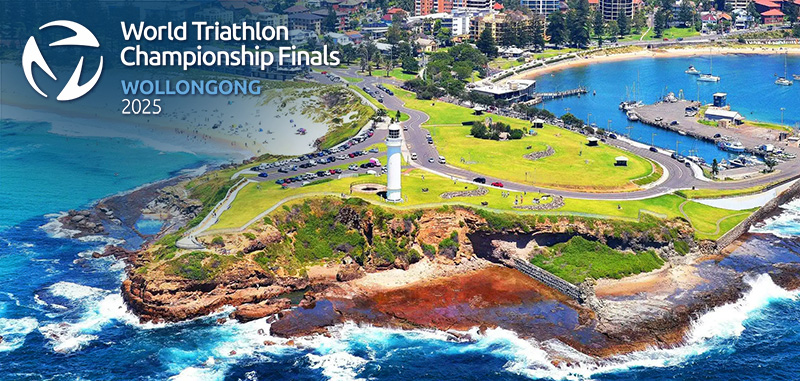It’s only seven years since the first ever aqaubike race took place in Australia. While the development wasn’t huge from the get-go, it gained some momentum with the announcement of the long-distance world championships taking place in Townsville 2024 and after Ironman events started including aquabike options in their races. Today every Ironman 70.3 event in Australia offers an aquabike option – and so do pretty much all other middle-distance races as well as many shorter and smaller events as well.
Last weeks race in Wollongong vividly showed what a success story this young aquabike discipline has been over the last few years in Downunder. Despite not a huge number of athletes travelling across the oceans from all around the world, no less than 430 aquabike athletes showed up at the start line, making it the second biggest race in the history of our sport. While the number of competitors was a bit below last year’s race in Torremolinos, the athlete’s race experience certainly wasn’t.

Despite offering a better start schedule and having a slightly lower number of competitors than in Torremolinos, I sill raised some concerns about the traffic on the bike course in my race preview. As it turned out, apparently unjustifiably so. I did not hear any concerns about bike course congestions and – other than in last year’s race in Spain – also the times of the strong cyclists do not suggest that they have been slowed down significantly.
But also, apart from that the race organization as well as the weather conditions ticked all the boxes for perfect race experience. As suspected in advance the swim part outside the harbour was a bit choppy. But other than that swim, transition, bike and finish offered a perfect setup. I highly recommend the future organizers of major events in Spain to take some lessons in Downunder.
The Men’s Race
It wasn’t a big surprise that strong swimmer Chris GRUENINGER was the first one to leave the water after 18 minutes and 36 seconds. He’s not one of the strongest cyclists though and the gap he had after the swim was clearly too small to stay in the top ranks on the bike course. Because some of the big favourites of the race came out right behind the leader. Last year’s overall runner up Terence JACK showed a remarkable performance in the Tasmanian Sea, coming into T1 only ten seconds behind, directly followed by 2022 world champion Nigel FANNING, with Damien BULTERS also only a few more seconds behind.
Kiwi athlete Stephen SHELDRAKE, who was third overall in Abu Dhabi in 2022, was another prerace favourite to come out of the water less than an minute behind the fastest swimmer, with Trent DAWSON 25 more seconds down. The strong cyclists amongst the pre-race favourites finished the swim quite close to each other. Hayden ARMSTRONG was the first of them to leave the water 02:35 minutes behind the leader. African champion Jean DE VILLIERS followed 17 seconds later with Christo BALL another 12 seconds behind.
After a quick transition Nigel FANNING and Terence JACK left T1seperated by only 3 seconds, with Chris GRUENINGER and Damien BULTERS also just a few more seconds down. Though it quickly showed who of them was the stronger cyclist that day. While Chris could not hold the pace of the top cyclists, Nigel also slowly but steadily increased his lead Terry and Damien who also passed the Kiwi athlete on the first few kilometres of the bike leg.
After the first half of the bike course, the Irishmen had a pretty clear lead of about 40 seconds to Stephen SHELDRAKE who just passed Damien to put himself into second position on the course. Not for too long though. Because Christo BALL came flying from behind, putting himself into the firs chaser’s position. After two of the three bike laps he had reduced his gap to the leader from four minutes to just about 30 seconds. While it looked much like a duell for the overall victory, the fight for the third spot on the podium seemed to be decided between Stephen SHELDRAKE, Damien BULTERS and Trent DAWSON who were separated by only 13 seconds at that point. Hayden ARMSTRONG was catching up but still had a gap of about a minute to the podium spot with only 13 km left to go.
With a strong finish Christo BALL took the lead about 8 km from the finish to bring home the overall victory on home soil. Long time leader of the race Nigel FANNING had to settle for second in the end, crossing the finish line 25 seconds behind the winner. Only 37 seconds later it was Hayden ARMSTRONG who had the better end in the fight for the last remaining spot on the podium. With the fastest last lap of the race, he put Stephen SHELDRAKE, Trent DAWSON, Damien BULTERS into the following ranks with Jean DE VILLIERS following closely – all within just one minute of the podium. Terence JACK came in 8th a minute later, holding off strong cyclist Luke SCHOFIELD by just two seconds, while Irishman Paul O’DOHERTY completed the top 10 about a minute later.
The Women’s Race
The women’s race of the 2025 standard distance world championships had what was probably the most thrilling final of any international aquabike race we have seen yet. With the top 5 athletes starting the last lap on the bike separated by only 48 seconds the rankings were all turned upside down on those last 13 km. But first things first.
After a remarkable swim performance it was Lauren WILSON who came first into T1. A swim time of 19 minutes and 57 seconds gave her a lead of more than a minute to British athlete Hayley DAVIS. From the other prerace favourites, Hayley LYALL was the next to come out of the water with a time gap of about two and a half minutes to the leader. Bec STEDMAN followed another 30 seconds behind, 17 seconds ahead of Kelly WRIGHT.
After a quick transition Lauren WILSON started the bike leg 2 minutes and 44 seconds ahead of Hayley DAVIS with Hayley LYALL another minute behind. While this remained to be the order of the podium ranks throughout the first half of the bike leg, the time caps where shrinking significantly. Just after half of the bike section Hayley DAVIS passed Lauren WILSON to take the lead in the race. Hayley LYALL also passed Lauren at the beginning of the last lap. At this point the three atheltes were separated by no more than 12 seconds. But some strong cyclists were closing the gap to the leading trio as well.
Hannah GIBSON started the bike leg 4:20 minutes behind the leader. After two of three laps the winner of the aquabike race at the Ironman 70.3 Western Sidney in September started the last lap in fourth position, having reduced the time gap to the leader to only 35 seconds. The winner of the aquabike race at the Ironman 70.3 Western Sidney in September started the bike leg 4:20 minutes behind the leader.
But also Lauren MYERS came closer and closer to the podium spots, starting the last lap only 13 seconds behind Hannah.
About 10 km from the finish, Hayley LYALL took the race lead from Hayley DAVIS, while Hannah GIBSON had already climbed up to third position at that point. While Hannah passed the British athlete with still a few km to go the fight for the overall victory unfolded on the very last part of the course.
In the end it was Hannah GIBSON who crossed the finish line first, only four seconds ahead of Hayley LYALL. Hayley DAVIS came in 31 seconds behind the winner, while Lauren MYERS and Lauren WILSON had to settle for 4th and 5th place. About two minutes behind the winner Kelly WRIGHT won a close fight for 6th place, finishing only five seconds ahead of Bec STEDMAN. Morgan PIKE, Kristin KUROKAWA and Amanda WOODD rounded out the top 10 in Wollongong.
» check out the full race results
Medal Table
| Rank | Country |  |  |  |
| 1. | Australia | 17 | 15 | 14 |
| 2. | United Kingdom | 7 | 4 | 2 |
| 3. | New Zealand | 5 | 3 | 2 |
| 4. | United States of America | 3 | 4 | 5 |
| 5. | Ireland | 1 | 1 | 1 |
| 6. | Austria | 1 | 1 | 0 |
| 7. | Denmark | 1 | 0 | 0 |
| 8. | Canada | 0 | 1 | 1 |
| 9. | Brazil | 0 | 0 | 1 |
| 10. | South Africa | 0 | 0 | 1 |
Not a big surprise here. As the medal table shows, Australian athletes have not only dominated the overall ranks, but also took the vast majority of medals in all age groups.
While the Competition Score of this year’s race was a bit lower than in the previous two editions (as you can see in the race history), the time gap from winner to 10th place of just about four minutes in both the men’s and the women’s race shows how high the performance density of aquabike athletes – especially in Australia – has become. I sincerely hope we will get to see some more of the strong Aussie athletes competing in the world championship races on the other continents in the next years.
While I would certainly like to see world championships with a more international competition, it’s quite heartwarming to see how well the race was organized and how positive the feedback from aquabike athletes was. A big thumbs up to Elite Energy, the organizers of the event, who have included aquabike options in their triathlon events for quite a few years now and offered a great setup and perfect stage for this world championship race.
